

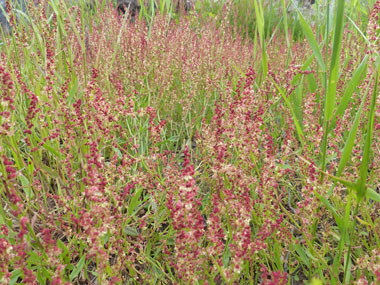
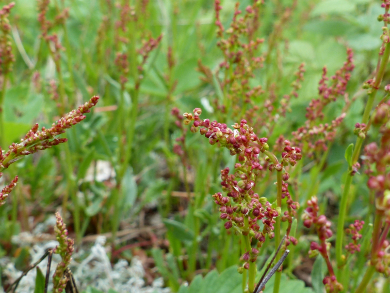

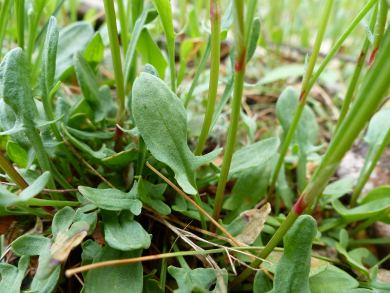
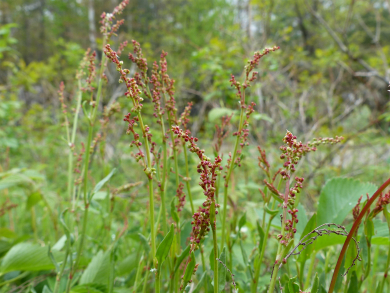
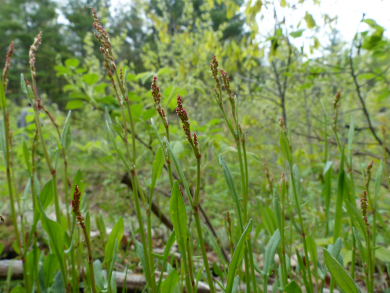
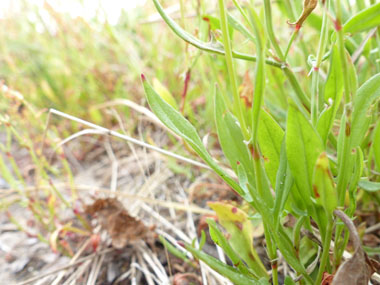
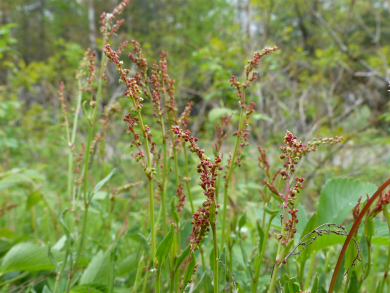
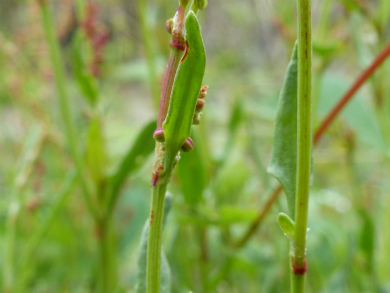
To support our efforts please browse our store (books with health benefits, etc.).
Sheep sorrel is a perennial plant that is in the buckwheat family. It reproduces by seed and by spreading horizontal roots. It is well recognized within the alternative cancer treatment community as one of the ingredients in Essiac tea.
Distinguishing Features
Sheep sorrel is composed of a clump of arrow-shaped leaves growing as a rosette which are joined underground by a creeping root system. In spring, each rosette forms a reddish upright flower stem. The seed-head looks like a miniature form of a broad-leaved dock seed-head which is hardly surprising as the two species are closely related. This plants grows in patches due to the creeping root system.
Flowers
Flowers are small, clustered in whorls in a branching inflorescence. This plant is unisexual so all flowers on one plant are either male or female. Female flowers tend to be greenish, male flowers yellowish, the whole plant is generally a reddish-green to brownish is colour. Sheep sorrel flowers from May to July.
 Fields
of Nutrition has medicinal benefits and vitamin/mineral content of Sheep Sorrel.
Fields
of Nutrition has medicinal benefits and vitamin/mineral content of Sheep Sorrel.
Leaves
Hairless leaves grow alternate (1 per node), variable in size and shape; lower leaves are long-stalked, arrowhead-shaped with a pair of slender lobes near the base of the blade, but occasionally can be slender and without lobes; middle leaves are short-stalked and nearly always have a lateral lobe on each side; upper leaves are stalkless.
Height
This plant has reddish upright stems and grows anywhere from 10 to 40 cm (4–16 in.) tall.
Habitat
The plant is native to Europe and Asia including the British Isles. It was introduced to North America and grows in many other areas of the world. It is commonly found in acidic, sandy soils in heaths and grassland. It particularly likes to grow in areas where blueberries can be found.
Edible Parts
The leaves have a lemony, tangy or nicely tart flavour. Leaves (in small quantities) can be eaten raw or cooked; used as thickeners in soups, dried and ground into a powder to use a flour or make into noodles. Seeds can be eaten raw or cooked.
Other Name
Red Sorrel.
Similar Plants
Garden sorrel.
Winter Survival Food Handbook

PDF Plant Magazines
Types of Wild Food
Geographic Zones Seasons
Disclaimer
EdibleWildFood.com is informational in nature. While we strive to be 100% accurate, it is solely up to the reader to ensure proper plant identification. Some wild plants are poisonous or can have serious adverse health effects.
We are not health professionals, medical doctors, nor are we nutritionists. It is up to the reader to verify nutritional information and health benefits with qualified professionals for all edible plants listed in this web site. Please click here for more information.
Why Edible Wild Food?
- Food costs are rising
- Free, wild food is readily abundant
- Wild food adds nutrition to your diet
- Wild food can help treat various medical conditions







